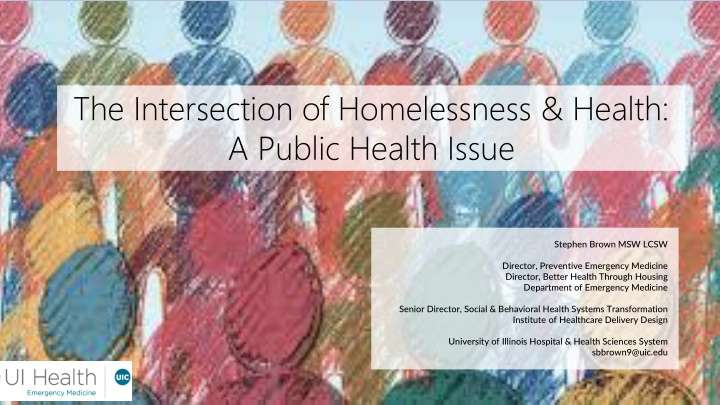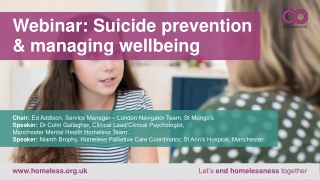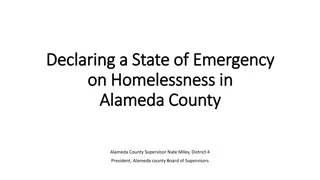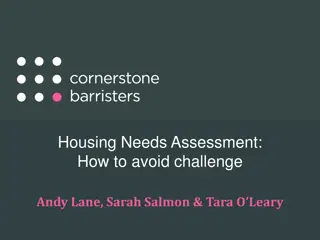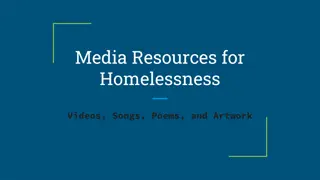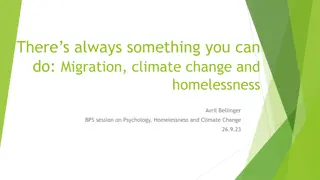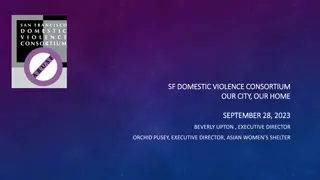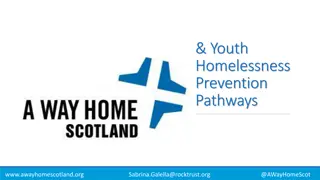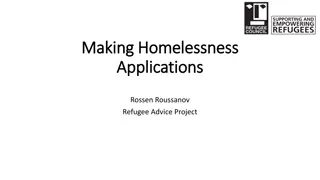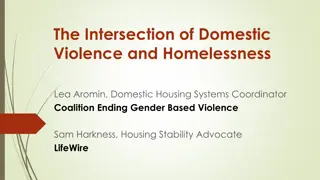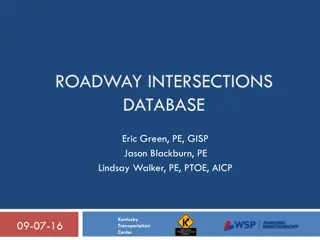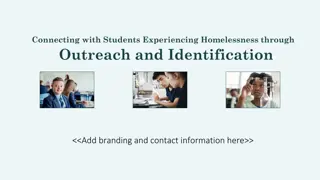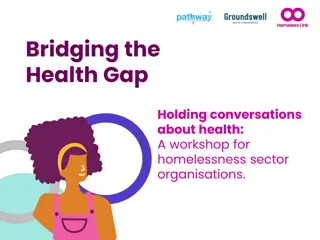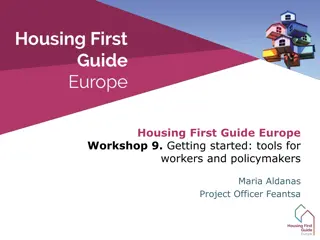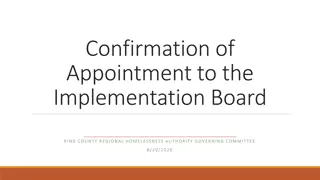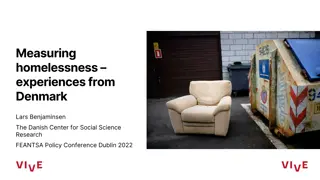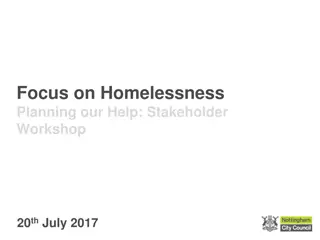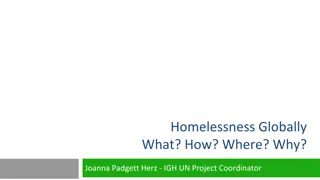Addressing the Intersection of Homelessness and Health
Exploring the critical issue of homelessness and its impact on health, this content delves into the challenges faced by individuals experiencing unstable housing situations. It highlights the early mortality rates and poor health outcomes associated with homelessness, particularly focusing on unsheltered individuals. The discussion also touches upon the efforts to decriminalize mental illness and substance use, advocating for diversion into treatment rather than law enforcement involvement. Various perspectives and initiatives in addressing homelessness from a public health standpoint are presented, emphasizing the need for systemic improvements and support services.
Download Presentation

Please find below an Image/Link to download the presentation.
The content on the website is provided AS IS for your information and personal use only. It may not be sold, licensed, or shared on other websites without obtaining consent from the author.If you encounter any issues during the download, it is possible that the publisher has removed the file from their server.
You are allowed to download the files provided on this website for personal or commercial use, subject to the condition that they are used lawfully. All files are the property of their respective owners.
The content on the website is provided AS IS for your information and personal use only. It may not be sold, licensed, or shared on other websites without obtaining consent from the author.
E N D
Presentation Transcript
The Intersection of Homelessness & Health: A Public Health Issue Stephen Brown MSW LCSW Director, Preventive Emergency Medicine Director, Better Health Through Housing Department of Emergency Medicine Senior Director, Social & Behavioral Health Systems Transformation Institute of Healthcare Delivery Design University of Illinois Hospital & Health Sciences System sbbrown9@uic.edu
Learning objectives Describe early mortality and poor health outcomes associated with unstable housing and homelessness, with a focus on unsheltered homelessness. It will also describe the broad trends occurring across the country to decriminalize mental illness and substance use, with examples of opportunities for diversion into treatment instead of engagement with law enforcement and incarceration. Provide examples of where the legal profession can advocate for change. Disclosures: I have no relevant financial or non- financial conflicts to report
Homelessness is what happens when every other system fails. - Alex Fox, Mayday Trust, Leeds, United Kingdom You could make many homelessness responses twice as effective if you managed the system better, but the inclination is always there to fund direct services. It s inefficient. If you want to shift the dial, fund the improvements to the systems . - Norman Suchar - U.S. Department of Housing and Urban Development
Emergency Medicine: The Safety Net Provider of Last Resort Upstream systems failures land at our doorstep
Housing Programs UI Health: Better Health Through Housing Chicago & Cook County: Flexible Housing Pool Since 2015: Longest running hospital-to-supportive housing program UI Health has housed more than any other single hospital (130) Over $1.75M invested Healthcare, insurance, philanthropy and city-county government financed consortium Over $20M invested Over 1,000 placed into permanent supportive housing
The changing face of homelessness If a person were asked to describe the homeless, they might talk about a middle-aged man on a street corner with a bottle of whisky in a brown paper sack. Although this stereotype is true for some, the population has shifted.
The changing face of homelessness The face of homelessness is changing. We are seeing more people who have been pushed out of their homes because of low wage jobs, rapidly rising rents and unemployment. One out of three Americans are living paycheck to paycheck, and if they lost their job, couldn t pay their rent or mortgage. 62% of Americans have no emergency savings for things like an emergency room visit or a $500 car repair.
Whats Driving the increase in homelessness Financial insecurity More people than ever are being housed but an even higher number are falling into homelessness Rents are out of reach for many, and millions of affordable places have disappeared Zoning laws and local opposition make it hard to build housing for low- income renters Pandemic aid programs that helped keep many people housed are winding down https://www.npr.org/2023/07/12/1186856463/homelessness-rent-affordable-housing-encampments
The 3 types of homelessness A time-oriented classification of the homeless, based upon the length of time they have been homeless. Both individuals (48%) and families (52%) who become homeless due to a housing, health care, or other financial crisis. They come into the shelter system and stay about three months and often move into housing. 50% are homeless less than 7 days. More individuals than families who regularly go in and out of shelters. They tend to be younger and leave shelters when they get income or use shelters seasonally. 31% of foster care children who age-out of the system will be homeless in their twenties Primarily individuals who have been homeless for a year or more, or four times in the last three years. They tend to be older with significant mental illness, substance abuse and many have a chronic medical condition(s). Chronically homeless can be further divided into sheltered and unsheltered status. 10% 80% 10% Transitional Episodic Chronic
Chronic Conditions % # Morbidity Asthma & COPD Hypertension Kidney Disease Diabetes Cancer Heart Failure Cancer-Metastatic Sickle Cell 70.0% 65.0% 40.0% 25.0% 20.0% 13.3% 10.0% 8.3% 42 39 24 15 12 8 6 5 Co-Morbidities# Complications From Homelessness, IV Drug Use Skin & Subcutaneous DVT & PE Osteomyelitis Endocarditis Traumatic Injury Frostbite Infectious Diseases Hepatitis HIV Tuberculosis Psychiatric & Neurocognitive Disorders Psychiatric Disorder Severe Mental Illness Neurocognitive Disorders Stroke Coma TBI Substance Use Disorders Tobacco Alcohol Opioids Cocaine Cannabis PCP 43.3% 10.0% 8.3% 1.7% ?? 5.0% 26 6 5 1 ?? 3 Zero 7% One 7% Five or More 32% Two 22% Four 10% Three 22% 25.0% 11.7% 3.3% 15 7 2 68.3% 60.0% 13.3% 8.3% 6.7% 6.7% 41 36 8 5 4 4 Zero One Two Three Four Five or More Trimorbidity The combination of: 71.7% 43.3% 43.3% 40.0% 38.3% 10.0% 43 26 26 24 23 6 56% Complex Chronic Condition(s) Substance Use Disorder Severe Mental Illness
A hidden epidemic: 72% of the chronically homeless have neurocognitive deficits Etiologies include severe mental illness, PTSD, uncontrolled seizure disorder, intellectual disability, traumatic brain injury (TBI), dementia, hepatic encephalopathy & childhood lead poisoning. Nearly 50% have evidence of traumatic brain injury Source: Stergiopoulos V, Cusi A, Bekele T, Skosireva A, Latimer E, Schutz C, Fernando I, Rourke SB. Neurocognitive impairment in a large sample of homeless adults with mental illness. Acta Psychiatr Scand. 2015 Apr; 131(4): 256-268.
Unsheltered homelessness were 25 times as likely to report having all three of the following conditions concurrently when compared to their sheltered peers: Physical health condition Mental health condition Substance abuse condition
Mortality All-cause mortality is higher than the general population Average life expectancy is 27.4 years less than the Average American Unsheltered homeless have higher mortality rate than all homeless BHH first cohort (2015) had 38.4% mortality rate Unsheltered Mortality Rate 3.6x higher than all homeless All-Cause Homeless Mortality Risk 12 10 8.9 9.8 10 8 8 6 6 4.5 4 4 2.7 2 2 0 0 0 Unsheltered Sheltered 25-44 45-64 65+ Source: Baggett TP, Hwang SW, O'Connell JJ, Porneala BC, Stringfellow EJ, Orav EJ, Singer DE, Rigotti NA. Mortality among homeless adults in Boston: Shifts in causes of death over a 15-year period. JAMA Intern Med. 2013 Feb 11; 173(3): 189-195.
Super- Utilizers According to the Robert Wood Johnson Foundation, a super- utilizer is a person whose complex physical, behavioral, and social needs are not well met through the current fragmented health care system.
Adult Super-Utilizers: A Preponderance of Behavioral Health Conditions & Homelessness Class Percent Description Behavioral Health Co-Morbidities 1 16% Alcohol use disorder and homelessness AUD & Homelessness 2 14% Medical conditions, mental illness, substance use disorders and homelessness 16% Mental Illness, Substance Use, homelessness & medical conditions 32% 14% Primarily Medical Conditions 3 25% Primarily medical conditions 13% 4 13% More serious mental illness, drug use disorders and homelessness 25% Serious Mental Illness, Drug Use Disorders and homelessness Medical Conditions with some mental illness and substance use disorders 5 32% Medical conditions with some mental illness and substance use disorders Source: Rinehart DJ, Oronce C, Durfee MJ, et al. Identifying Subgroups of Adult Superutilizers in an Urban Safety-Net System Using Latent Class Analysis: Implications for Clinical Practice. Med Care. 2018;56(1):e1-e9.
Cost Implications for common chronic diseases
Medicaid Super- Utilizers On average, 5% of all U.S. Medicaid clients account for 48% of healthcare delivery costs In Illinois, 5% of all Medicaid clients accounted for 62.5% of all Medicaid healthcare delivery costs
Preventable Costs Research indicates that up to 42% of costs in both high-cost & non- high-cost cohorts are preventable Source: Joynt, K. E., Gawande, A. A., Orav, E. J., & Jha, A. K. (2013). Contribution of preventable acute care spending to total spending for high-cost Medicare patients. JAMA, 309(24), 2572-2578. doi:10.1001/jama.2013.7103
Decriminalization of Mental Illness & Substance use 988 replaced the National Suicide Prevention Line Immediate access to a mental health professional 85% of calls answered in-state Second phase will be to create behavioral health resources to divert people to. Sequential Intercept Model in Criminal Justice
Assisted Outpatient Treatment (AOT) Assisted outpatient treatment (AOT) is court-supervised treatment within the community for patients with serious mental illness. AOT laws have been shown to reduce hospitalization, arrest and incarceration, homelessness, victimization, and to prevent violent acts associated with mental illness, including suicide and violence against others. For families that lack resources, AOT can be the single avenue for guiding their loved ones into treatment
Diversion Programs Police Crisis Intervention Team (CIT) 40-hour training in de-escalation, recognition of mental illness & substance use Guardians & Warriors Co-Responder Model CAHOOTS (Eugene OR) STAR (Denver) CARES Team (Chicago)
Programs addressing super-utilizers Increase access to AOT Increase access & capacity of the 311-shelter system New Assertive Community Treatment (ACT) outcomes-based model Strategic Plan for State Owned Psychiatric Hospitals State of Illinois Homeless Health Dashboard & Report 1115 Waiver Medical Respite Care Certified Community Behavioral Health Center (CCBHC) City of Chicago Sobering Center
Questions? Stephen Brown MSW LCSW Stephen Brown MSW LCSW Director, Preventive Emergency Medicine University of Illinois Hospital & Health Sciences System sbbrown9@uic.edu 312-996-4859
Chicago: Homelessness Annual Point-in-Time Count (PIT) 2022 311 requests for shelter Source: Chicago Department of Family and Support Services (DFSS), Annual Point In Time Count (7/17)
